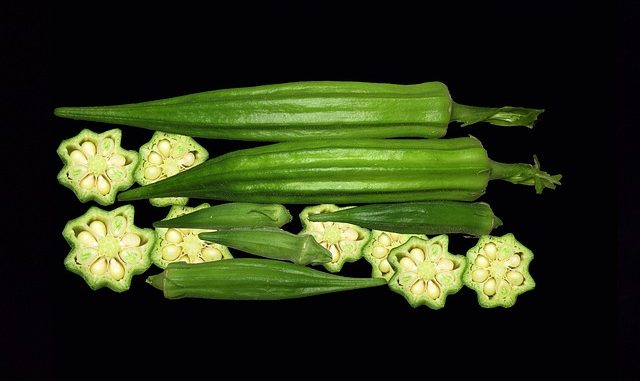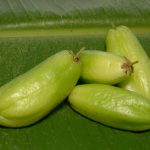
Okra (Abelmoschus esculentus) is a widely cultivated and consumed vegetable in tropical and subtropical countries. It is also known as bhindi or lady’s fingers, in reference to the long, elegantly tapering shape.
Originally an African vegetable, nowadays, the most important okra producing countries are India, Nigeria, Pakistan, Ghana, and Egypt. It is widely used in all sorts of cuisines from Caribbean, Creole, Cajun to Indian.
Appearance
Ridged along its length, the green, slightly fuzzy pod contains rows of edible seeds that release a mucilaginous (sticky, viscous) liquid when chopped and cooked, which has led to it being used to thicken soup and stew recipes, such as Cajun gumbo, but it’s also served whole as a side dish.
Nutrition
Okra is a source of protein, vitamins C and A, iron, and calcium (Aworh et al. 1980; Ihekoronye and Ngoddy, 1985) and dietary fiber (Adom et al. 1996).
| Nutritional value per 100 g (3.5 oz) | |
| Energy | 138 kJ (33 kcal) |
| Carbohydrates | 7.45 g |
| Sugars | 1.48 g |
| Dietary fiber | 3.2 g |
| Fat | 0.19 g |
| Protein | 1.9 g |
| Vitamins | |
| Vitamin A equiv. | (5%) 36 μg |
| Thiamine (B1) | (17%) 0.2 mg |
| Riboflavin (B2) | (5%) 0.06 mg |
| Niacin (B3) | (7%) 1 mg |
| Folate (B9) | (15%) 60 μg |
| Vitamin C | (28%) 23 mg |
| Vitamin E | (2% ) 0.27 mg |
| Vitamin K | (30%) 31.3 μg |
| Minerals | |
| Calcium | (8%) 82 mg |
| Iron | (5%) 0.62 mg |
| Magnesium | (16%) 57 mg |
| Phosphorus | (9%) 61 mg |
| Potassium | (6%) 299 mg |
| Zinc | (6%) 0.58 mg |
| Other constituents | |
| Water | 89.6 g |
Okra contains large quantities of glycans, which are responsible for the viscosity of aqueous suspensions (Owoeye et al. 1990) and the stringy, gum-like consistency that is particularly desirable in soups.
References
Adom, K. K., Dzogbefia, V. P., Ellis, W. O., & Simpson, B. K. (1996). Solar drying of okra-effects of selected package materials on storage stability. Food Research International, 29(7), 589–593. doi:10.1016/S0963-9969(96)00076-2.
Aworh, O. C., Olorunda, A. O., & Akibo, O. (1980). Quality attributes of frozen okra as influenced by processing and storage. Journal of Food Technology, 15, pp. 429–433
Ihekoronye, A. I., & Ngoddy, P. O. (1985). Integrated food science and technology for the tropics pp. 205–206, 293. London: Macmillan.
Owoeye, A. L., Laurie, M. C., Allagheny, N. N., & Onyezili, F. N. (1990). Chemical and physical parameters affecting the viscosity of mixed okra and tomato homogenate. Journal of the Science of Food and Agriculture, 53, 283–286. doi:10.1002/jsfa. 2740530218


Leave a Reply